 W
WBan Hin Kiong is a Taoist temple at jalan D.I. Panjaitan, Manado. It is the oldest temple in the city of Manado. This temple was established in 1819, then in 1893 there was built a shrine or known as Tek Kong Su in Hokkien. At the beginning, the building was made of bamboo wood.
 W
WPrince Bi Gan or Bigan was a prominent Chinese figure during the Shang dynasty. He was a son of King Wen Ding, and an uncle of the last Shang king, Di Xin. He is immortalized as a Taoist deity. His ancestral name was "Zi" (子).
 W
WChengxu Temple (澄虚道院) is a Taoist temple located in Zhouzhuang which was built in 1086-1093 during the Song Dynasty. Also known as Sanctity Hall it is located on Zhongshi Street opposite Puqing Bridge in Zhouzhuang, After several periods of expansion, it grew into one of the most notable Taoist temples in Wuzhong. With an area of 1,500 square meters, it consists of simple but majestic Shengdi and Doumu halls, Yuhuang, Wenchang and Shengdi pavilions which are masterpieces of Taoist architecture.
 W
WChing Chung Koon is a Taoist Temple and active Taoist organisation located in Tuen Mun, Hong Kong.
 W
WCihang Zhenren is a Daoist deity who is identified with the Buddhist bodhisattva Guan Yin. Cihang Zhenren is one of the Three Great Immortals and became a bodhisattva because of his endless willingness and effort in helping those in need.
 W
WDajiao, called the Taiping Qingjiao or Taai ping ching jiu in Hong Kong, (太平清醮) is a Taoist ritual and festival which is performed every year.
 W
WDaode Tianzun, also known as Taishang Laojun is a high Taoist god. He is the Taiqing which is one of the Three Pure Ones, the highest divinities of Taoism.
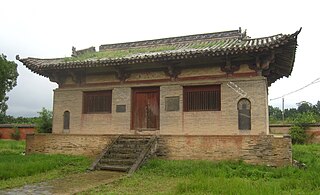 W
WThe Five Dragons Temple is a Taoist temple in Ruicheng, Shanxi Province, China. It is also known as King Guangren's Temple (广仁王庙).
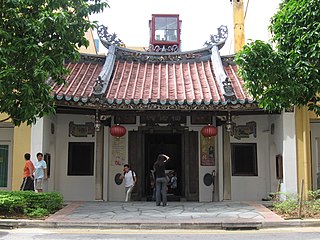 W
WThe Fuk Tak Chi Temple was one of the oldest former temple in Singapore which has turned into a museum, built in 1824 by Cantonese and Hakka immigrants from Kwong Wai Siew (广惠肇三府). Two other Hakka clans, Fong Yun Thai and Ying Fo Fui Kun joined in 1854 after contributing to the temple's rebuilding project. Dedicated to Tua Pek Kong, it is a Chinese folk religion temple which caters to the religious needs of both Chinese folk religionists and Taoists.
 W
WGrotto-heavens are a type of sacred Taoist site. Grotto-heavens are usually caves, grottoes, mountain hollows, or other underground spaces. Because every community was supposed to have access to at least one grotto, there were many of them all over China. They were first organized systematically in the Tang Dynasty by Sima Chengzhen 司馬承禎 and Du Guangting 杜光庭 (850-933). The most sacred of these sites were divided into two types: The ten greater grotto-heavens and the thirty-six lesser grotto-heavens.
 W
WHe-He Er Xian, translated as the Immortals of Harmony and Union and as the Two gods of Harmony and Union, are two Taoist immortals. They are popularly associated with happy marriages. He and He are typically depicted as boys holding a lotus flower and a box.
 W
WJìngxiāng, shàngxiāng, bàishén, is a ritual of offering incense accompanied by tea and or fruits in Chinese traditional religion. In ancestral religious worship it's jìngzǔ or bàizǔ 拜祖. It is observed by a devotee holding joss incense with both hands in front of an altar during the worship. For greater reverence or devotion, the devotee will kneel and bow before the altar during and after placing the incense inside the urn at the altar.
 W
WLi Jing, also known as Pagoda-Bearing Heavenly King Li is a figure in Chinese mythology and a god in Chinese folk religion. He carries a tower that can capture any spirit, demon or god within its walls. He also appears in the classic Chinese novels Journey to the West and Fengshen Yanyi. He is an analogue of Vaisravana.
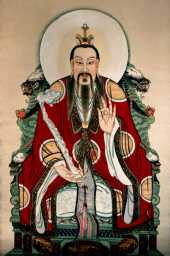 W
WLingbao Tianzun, also known in English as the Heavenly Lord of Spiritual Treasures, is a Taoist god. Also known as Shangqing, he is numbered among the Three Pure Ones who head some forms of the Taoist pantheon.
 W
WThe Ma-Tsu Temple is a Taoist temple in San Francisco's Chinatown. Founded in 1986, it is dedicated to Mazu and has foundational ties to the Chaotian Temple in Beigang, Yunlin, Taiwan.
 W
WMei Bo was an official of Shang dynasty and was killed by Di Xin, King Zhou of Shang.
 W
WMount Longhu is located in Jiangxi, China. It is famous for being one of the birthplaces of Taoism, with many Taoist temples built upon the mountainside. It is particularly important to the Zhengyi Dao as the Shangqing Temple and the Mansion of the Taoist Master are located here. It is known as one of the Four Sacred Mountains of Taoism.
 W
WMount Miaofeng is a mountain in the northwestern Beijing, an extension of the Taihang Mountains. It is located in the Mentougou District of Beijing about 70 kilometers to the northwest of downtown Beijing.
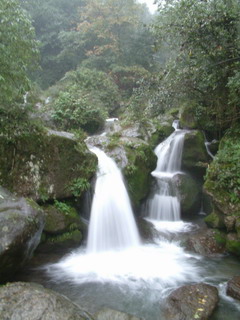 W
WMount Qingcheng is a mountain in Dujiangyan, Sichuan, China.
 W
WMuzha is a figure in Chinese mythology and a god in Chinese traditional religion.
 W
WThe Old Man of the South Pole is the Taoist deification of Canopus, the brightest star of the constellation Carina.
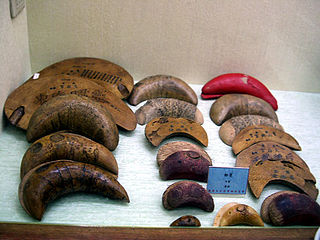 W
WPoe divination is a traditional Chinese divination method, in which the divination seeker throws or drops two little wooden pieces on the floor and gets the divine answer by the positions of the pieces whether the future course being contemplated is recommended or not. The pieces, called "Poe" (Bwei) in Taiwanese or Jiaobei in Mandarin, look somewhat like two shells of a clam or bivalve mollusk.
 W
WThe Zixiao Palace or Purple Cloud Temple, standing on Zhanqi Peak, is a Taoist temple of the Wudang Mountains Taoist complex in the northwestern part of Hubei, China.
 W
WSan Ching Tian Temple is a Chinese temple located in a 1.5-acre site bordered by housing area in Krokop 9 Road of Miri, Sarawak, Malaysia, where it is also considered as the largest Taoist temple in Southeast Asia.
 W
WShigandang is an ornamental stone tablet with writings, which is used to exorcise evil spirits in east Asia. The Shigandang are often associated with Mount Tai and are often placed on street intersections or three-way junctions, especially in the crossing, which is often considered a spiritually dangerous place (凶位). Apart from Shigandang, another option will be placing a stone written with Nāmó Ēmítuófó (南無阿彌陀佛).
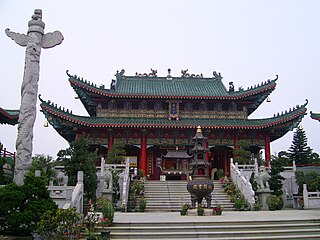 W
WTaoism in Hong Kong is the religion of approximately 14% of the population. This figure did not include the large number of local population who are following Chinese folk religious traditions without indicating their religious affiliation.
 W
WWhile there are many historical and modern schools of Taoism with different teachings on the subject, many Taoist priests regard their diet as extremely important to their physical, mental and spiritual health in one way or another, especially where the amount of qi in the food is concerned.
 W
WThe Taoist Temple at No. 12 China Alley in Hanford, in Kings County, California, dates from 1893. It was listed on the U.S. National Register of Historic Places (NRHP) in 1972.
 W
WTay Kak Sie Temple is a Taoist temple located at Jalan Gang Lombok, Semarang. The temple was established in 1746. This was originally only to worship the Goddess of Mercy, Guan Yin. This pagoda later developed into a large temple which also worshipped many Taoist Deities.
 W
WThe Temple of the Jade Mountain is located on the Jade Islet in Hoàn Kiếm Lake, central Hanoi, Vietnam.
 W
WWang Ye worship is a Fujianese and Taiwanese folk religion, frequently considered an aspect of the Taoist belief system. Wang Ye is particularly worshiped in Southern Taiwan.
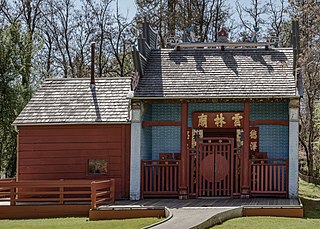 W
WWeaverville Joss House State Historic Park is a state park located in the center of the town of Weaverville, California. The site is a Taoist temple which is still in use, and is the oldest Chinese temple in California.
 W
WWenshu Guangfa Tianzun is a Taoist deity and character in the classic Chinese novel Investiture of the Gods. He is a disciple of Yuanshi Tianzun and one of the Three Great Immortals. The character is believed to be derived from the bodhisattva Manjusri. The books Qunxian Xianpo Tianmen and Western Tang Dynasty Biography states Wenshu Guangfa Tianzun and Manjusri Bodhisattva are not the same person.
 W
WYuding Zhenren (玉鼎真人) is a Taoist deity and character in the classic Chinese novel Fengshen Yanyi. He is one of the twelve golden immortals. His disciple is Yang Jian and he taught him fighting and magical skills including the 72 earthly transformations.